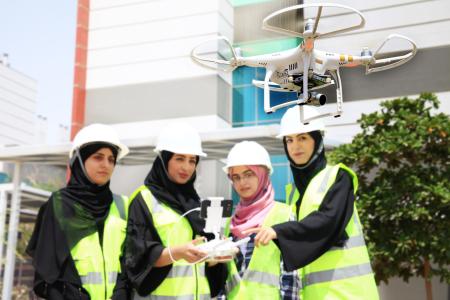Potential ways of using drone technology to benefit research and education in the UAE, and foster a love of scientific discovery among more students, have been outlined by researchers at United Arab Emirates University (UAEU).
The group have produced a research paper which details an approach for understanding and evaluating the performance of Unmanned Aerial Vehicles (UAVs) – commonly known as drones – and for testing new 3D-mapping software in real-life environments, with the aim of helping to define how the technology can support the UAE’s goals.
Drawing on two case studies of training and fact-finding exercises in the UAE, the researchers – Dr Khaula Alkaabi and Dr Abdelgadir Abuelgasim, of the Department of Geography and Urban Planning within UAEU’s College of Humanities and Social Sciences – said their findings demonstrate how drones are “an excellent vehicle for student learning and research”, and might encourage more students to get involved in research.
In their paper, ‘Applications of Unmanned Aerial Vehicle Technology for Research and Education in UAE’, Dr Alkaabi and Dr Abuelgasim said advances in 3D mapping can allow students to “master the skills of geospatial technology”, adding: “This helps them to learn how to use critical thinking and practical application in making well-reasoned decisions and to solve research problems in a 3D environment. It will extend their skills and enhance their competitiveness in the job market.”
Following a workshop and training project on UAV remote sensing and photogrammetry in Dubai in March 2017, organized by the Arabian Gulf University and the BCN Drone Center, UAEU’s Al Ain campus was the venue for a further workshop organized by Abu Dhabi Systems & Information Centre. Attended by students, researchers, and faculty from UAEU, it saw high-resolution aerial images of the university being collected and allowed views and opinions about the use of 3D mapping technology to be shared.
During the exercise, the drone collected about 75 images from the air, allowing the performance of the vehicle to be assessed and potential issues and errors to be identified, including the impact of weather conditions, safety and security, time, and area of coverage.
In their research paper – which highlighted the capabilities and performance of both rotary-wing and fixed-wing drones – Dr Alkaabi and Dr Abuelgasim said: “UAVs provide an excellent technological tool through which students are able to learn through a project, or through learning by doing.
“Learning by doing through the use of UAVs will likely help students develop their own innovative ideas toward further application and use of UAVs, as well as ideas related to improved drone technology and hardware.”
The researchers said the high-resolution 3D images produced by drones have the capacity to support rapid response in critical and high-risk situations, through their ability to reach otherwise inaccessible locations, although they still have some technical boundaries, such as battery life limiting flight duration, and the effect of wind speed on how they operate.
However, they said: “The new trend of drone technology and its application attracts students who might not otherwise get involved in research activities, and this new technology also plays a significant role in motivating them for their technical projects.
“The training and hands-on experience provided in the workshops has delivered a scientific tool to the students, both for taking it as a career and guiding them for their course projects. Working seriously with 3D applications requires substantial outlay, but learning opportunities are much higher and have great value in the job market.”




